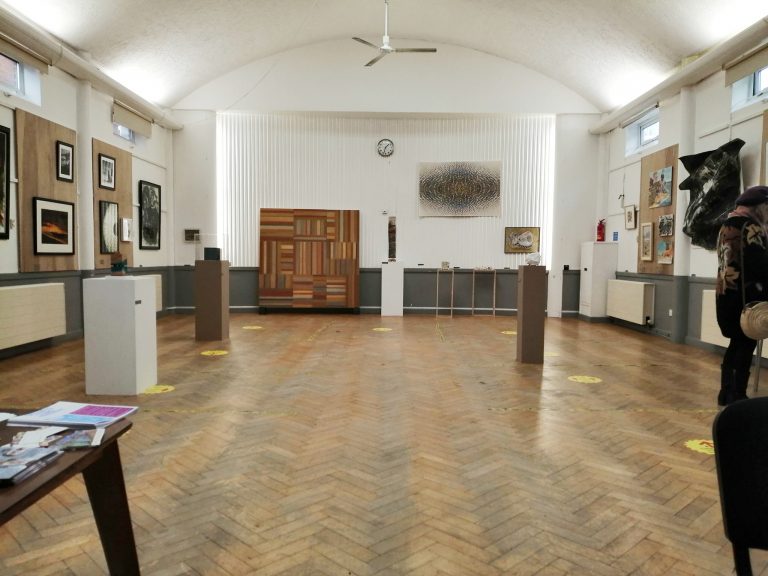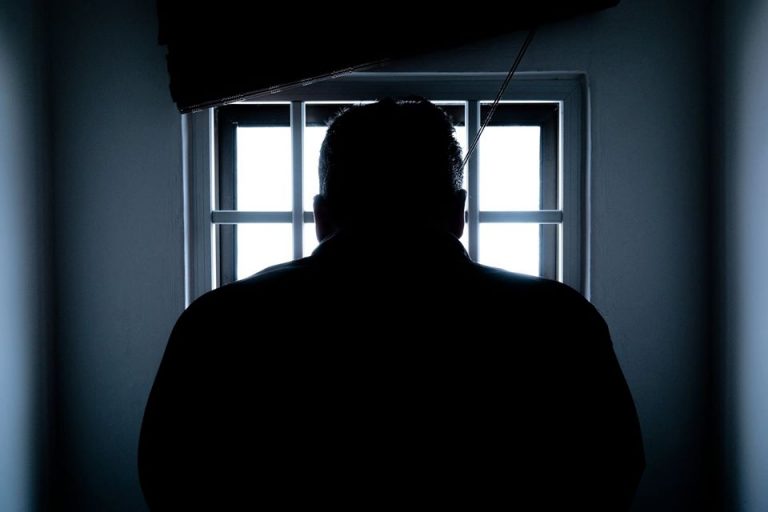
10 to 21 August 2023
This exhibition brings together four artists who are making work with found materials and pigments. Finding and preparing their own materials creates a personal and physical link with particular environments for these artists, who are exploring ecological issues in a variety of ways.
Sam Hodge is showing work made by printing directly from unfolded packaging foraged from her own recycling bin. They are printed in inks made with earths pigments found in eroding cliffs on the coast of Devon. The ambiguous, sometimes animate forms that emerge, trace both the history of her own consumption and of the slow geological processes that created these coloured earths and then revealed them at the uncertain edges of England.
Inspired by the renovation of his Derbyshire house and studio, Geoff Litherland works with traditional wall painting technique of buon fresco, applying earth pigments including meteorite to drying lime plaster through hemp nets. He is seeking a more ecological approach not just by working with locally made and foraged materials, but also by removing intentionality and allowing ethereal patterns and forms to slowly emerge in the solid plaster.
During lockdown, Liz McGowan‘s work as an environmental artist became focused on her immediate surroundings, amongst these was a bag of soot from her own chimney. Asking questions about her own complicity in climate change, she has combined this soot with the remains of living things that share her environment (rodent teeth, lichen, and mussel shells). She has also sprinkled it onto chalk from the eroding Norfolk Chalk Reef (revealed only at very low tides) recording traces of the bryozoa and seaweeds that once lived there.
Yelena Popova was bought up in a secret Soviet nuclear settlement. Now living in the UK, she has gathered earths from places close to nuclear power stations, mixing with distemper to create swirling ‘post petrochemical’ paintings that are part of her search for a more sustainable way of living.
Sam Hodge is a painter and printmaker based in East London. She originally studied Natural Sciences and then trained and worked as a painting restorer before beginning to play seriously and making her own artwork in 2008.
Focusing on transformations in matter over time, she explores human entanglement with the material world and our reactions to its shifting and unstable nature. She often works with found materials. In this exhibition she is showing some of a series of prints taken directly from unfolded packaging from her own recycling bin. These have been printed in inks made with pigments that the artist has gathered from cliffs on the Devon coast. Ambiguous, sometimes animate forms emerge that are open to interpretation. Traces recording her own consumption made with ochres formed in Permian Deserts or deposited in the Ice Age, which are now revealed by the erosion at the uncertain edges of England.
She has exhibited widely in The UK and abroad. Exhibitions include: Every Contact Leaves a Trace (solo show, 195 Mare Street, London, 2023) Once Upon an Instance (Bildhauer Halle, Berlin, 2022) RA Summer Exhibition (Royal Academy, London 2022, 2019, 2015) Ground Work (APT Gallery, London 2021 ); Radical Residency VI, (Unit 1 Gallery, London, 2021); Doom and Bloom (Contemporary Art Society, London, 2019); As the Crow Flies (Bo.Lee Gallery, London, 2019); Vital Matter (solo show, Muse Gallery, London, 2019); Wells Art Contemporary (Wells, 2018); In Residence, (Griffin Gallery, London 2017); International Print Biennale (Newcastle, 2016) Creekside Open (APT Gallery, London, 2015) A Series of Unfortunate Events (Hack the Barbican, Barbican Centre, 2013). Her artists book ‘A Catalogue of Misfortune’ is in in several public collections including MOMA and The Metropolitan Museum in New York and her prints and paintings are held in numerous British and international private collections.
Geoff Diego Litherland was born in Mexico and is currently based in Wirksworth, Derbyshire. In 2012 he completed an MFA in Fine Art at Goldsmiths University of London, he is an artist with a considerable exhibition profile, and a part-time lecturer at Nottingham Trent University.
In my recent work I have sought to delve deeper into the interconnected threads between painting and the environment, not just through using locally made and foraged materials but through setting measured parameters to the process of making the work, seeking a more ecological approach I remove intentionality and sense of control allow patterns and forms to slowly emerge.
These works use the technique of Buon fresco: a traditional method of applying pigments to drying lime plaster that predates oil painting on canvas. It was made while I was renovating my current house and studio, a gritstone and limestone building in Derbyshire.
Hemp nets were cast onto the wet plaster to catch the falling earth pigments which were carefully interspersed onto the surface before the materials carbonated and turned to reconstituted stone. The darker constellation or crater like marks are made with meteorite pigment.
The work is a heavy slab of solid plaster, yet has a lightness to it, forming a distorted visual depth that seeks to capture the ethereal and ephemeral qualities of that which makes up the emptiness of the universe, an attempt to visualise the invisible, a metaphysical exploration of matter in space: solid air.
Liz McGowan: During lockdown my work as an environmental artist became focussed upon my home and the land immediately around it. I found myself exploring my locality and digging deep into my store room for materials that I had collected and never used. Amongst these was a small bag of soot from my chimney, and it brought home to me my own culpability with regard to the greater threat of climate change.
Complicity, a conversation between materials
Chimney soot forms a bed for lichen, mussel shells and rodent teeth (from owl pellets). All organic and found close to home. One is a toxic by product of my human activity, the others are parts of small, delicate beings around me whose existence is direly threatened by my/our excessive carbon emissions. The soot from my chimney represents my complicity in this process.
The life of where I live cheek by jowl with the pollutants produced by me.
Absence II, the Norfolk chalk reef
There are only about three days in the year when the murky seawater clears to reveal the marvels of the Norfolk chalk reef, just off the coast from Artspace on the Prom. It is a rich, but hidden world that runs for about 20 miles along our coastline. And there has been a gradual erosion of this ecosystem due to human activity.
Chimney soot is sprinkled onto a ground of chalk to record the shadows of delicate seaweeds and bryozoa that once lived in the reef. Again, the chimney soot puts me in front of the way in which my actions impact upon these delicate ecosystems.
Yelena Popova works across a range of media, including painting, tapestry, video and installation. There is a stress placed upon the notion of balance within her work, whether political, aesthetic or metaphysical.
Reflecting her upbringing in the USSR, she is influenced by the tenets of Russian Constructivism, while often seeking to discuss the constant development of industrialism and the landscape of contemporary capitalism.
Growing up in a secret Soviet nuclear settlement, Popova has turned her attention to nuclear history and heritage undertaking series of research trips around decommissioned nuclear power plants in the UK to produce the Scholar Stones Project commissioned by Holden Gallery, Manchester in 2020.
Yelena was born in the Urals in the USSR and has lived in the UK for over twenty years. She now lives and works in Nottingham. She graduated with an MA in Painting from the Royal College of Art in 2011. Her work was included in Slow Painting curated by Martin Herbert for Hayward Gallery touring programme (2019) and in Vitamin P3 (New Perspectives in Painting) published by Phaidon (2016). She was shortlisted for the Arts Foundation Award in Painting and was included in 100 Painters of Tomorrow published by Thames and Hudson (2014).
Yelena has attended a number of residencies, among them Girton College; The Art House, Wakefield; CCA Andratx, Mallorca. Recent solo exhibitions include: Landscapes of Power, Philipp von Rosen, Cologne; The Scholar Stones Project, Holden Gallery, Manchester (2020); Her Name is Prometheus, L’etranger, London; Townlets, Art House Wakefield (2018); After Image, Nottingham Contemporary (2016) and Unsensed, Hatton Gallery, Newcastle (2015).






